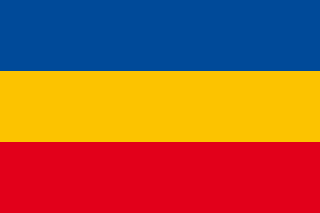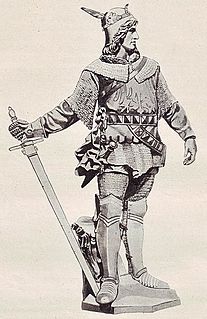
The Duchy of Mecklenburg-Strelitz was a duchy in northern Germany consisting of the eastern fifth of the historic Mecklenburg region, roughly corresponding with the present-day Mecklenburg-Strelitz district, and the western exclave of the former Bishopric of Ratzeburg in modern Schleswig-Holstein. At the time of its establishment, the duchy bordered on the territory of Swedish Pomerania in the north and of Brandenburg in the south.

The Duchy of Mecklenburg-Schwerin was a duchy in northern Germany created in 1701, when Frederick William and Adolphus Frederick II divided the Duchy of Mecklenburg between Schwerin and Strelitz. Ruled by the successors of the Nikloting House of Mecklenburg, Mecklenburg-Schwerin remained a state of the Holy Roman Empire along the Baltic Sea littoral between Holstein-Glückstadt and Duchy of Pomerania.

The House of Mecklenburg, also known as Nikloting, is a North German dynasty of Slavic origin that ruled until 1918 in the Mecklenburg region, being among the longest-ruling families of Europe. Queen Juliana of the Netherlands (1909–2004), former Queen of the Netherlands (1948–1980), was an agnatic member of this house.
Starogard, Starogród, or Stargard means old fort or old city in Polish, Polabian and Pomeranian languages, and gard is Old Slavic, Old Germanic, Old Baltic, and Old Finnic for castle or fortification. Places with those names include:

Waldemar the Great, a member of the House of Ascania, was Margrave of Brandenburg-Stendal from 1308 until his death. He became sole ruler of the Margraviate of Brandenburg upon the death of his cousin John V of Brandenburg-Salzwedel in 1317. Waldemar is known as the last in the line of Ascanian margraves starting with Albert the Bear in 1157; he was only succeeded by his minor cousin Henry II, who died one year later.

Burg Stargard (Polabian Stargart, is a small town in the Mecklenburgische Seenplatte district, in Mecklenburg-Vorpommern, Germany. It is situated 8 kilometres southeast of Neubrandenburg.

The Grand Duchy of Mecklenburg-Strelitz was a territory in Northern Germany, held by the younger line of the House of Mecklenburg residing in Neustrelitz. Like the neighbouring Grand Duchy of Mecklenburg-Schwerin, it was a sovereign member state of the German Confederation and became a federated state of the North German Confederation and finally of the German Empire upon the unification of 1871. After World War I and the German Revolution of 1918–19 it was succeeded by the Free State of Mecklenburg-Strelitz.

Mecklenburg-Stargard was one of two into two duchies of form from the split of Mecklenburg from 1348 to 1471. The other was Duchy of Mecklenburg-Schwerin.
John I, Duke of Mecklenburg-Stargard, Duke of Mecklenburg from 1344 to 1352 and Duke of Mecklenburg-Stargard from 1352 to 1392.
Ulrich II, Duke of Mecklenburg-Stargard was ruling duke in the portion of the duchy of Mecklenburg designated Mecklenburg-Stargard from 1466 to 1471. He was the youngest child of Duke Henry, Duke of Mecklenburg-Stargard, and his wife Ingeborg of Pomerania.
Henry II, Lord of Mecklenburg, nicknamed the Lion was regent of Mecklenburg from 1287 to 1298, co-regent from 1298 to 1302 and ruled alone again from 1302 to 1329.
Henry, Duke of Mecklenburg-Stargard was the ruling Duke of Mecklenburg-Stargard, including the Lordships of Neubrandenburg, Stargard, Strelitz and Wesenberg, from 1417 to 1466. He is sometimes called "Henry the Elder" to distinguish him from Duke Henry IV of Mecklenburg.
Ulrich I, Duke of Mecklenburg-Stargard was Duke of Mecklenburg-Stargard from 1392 or 1393 until his death. He was also Lord of Neubrandenburg, Stargard, Strelitz and Wesenberg.
Beatrix of Brandenburg was the first wife of Lord Henry II "the Lion" of Mecklenburg (1266–1329), whom she married in 1292 at Stargard Castle.
John III, Duke of Mecklenburg-Stargard was from 1416 to 1438 Duke of Mecklenburg, Lord of Stargard, Sternberg, Friedland, Fürstenberg, and Lychen. To distinguish him from John V, Duke of Mecklenburg, he is sometimes called John the Elder.
Albert III, Margrave of Brandenburg-Salzwedel was a Margrave of Brandenburg. He was a member of the Brandenburg-Salzwedel branch of the House of Ascania, which existed from 1266 to 1317. He was a son of Otto III and his wife, Beatrice of Bohemia.
Albert II, Duke of Mecklenburg-Stargard was Duke of Mecklenburg-Stargard and Lord of Neubrandenburg, Lordship of Stargard, Strelitz and Wesenberg from 1417 until his death.

Stargard Castle is the northernmost extant hill castle in Germany. The 13th century castle, standing on a 90 m hill, and the eponymous small town in the valley below lie several kilometers southeast of Neubrandenburg, in the northeastern German state of Mecklenburg-Vorpommern. The complex consists of an outer and an inner bailey with eleven buildings preserved. The imposing castle keep serves as the city's landmark.
During its history, the state of Mecklenburg has been repeatedly partitioned into various successor states. Modern historians distinguish three main Partitions of Mecklenburg:





